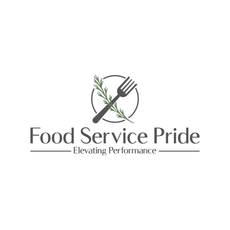Our Vision
To be the leading strategic partner for foodservice manufacturers, suppliers, and operators—driving innovation, growth, and excellence across the hospitality industry. We envision a future where collaboration, education, and operational performance empower every stakeholder to thrive.
Our Mission
Food Service Pride exists to elevate the foodservice and hospitality ecosystem by connecting manufacturers and suppliers with operators through tailored consulting, coaching, and strategic partnerships. We champion workforce development, customer experience, and financial performance by integrating best-in-class solutions and fostering meaningful relationships.
Our Strategic Pillars
- Growth Acceleration – Launch and scale emerging brands with precision and momentum
- Cultural Storytelling – Build brand narratives that connect across cultures and communities
- Market Penetration – Navigate the U.S. foodservice landscape with tailored strategies
- Vendor Partnership Maximization – Strengthen relationships that drive mutual success
Our Broader Commitment
We are passionate about promoting health and wellness for our clients, vendor partners, and our cohesive team of consultants. We believe food is more than nourishment. It’s a force for connection, culture, and well-being.
We are building an inclusive and diverse community of experts in foodservice management and food safety through:
- Consulting – Expert guidance to elevate operations and innovation
- Education – Continuous learning for clients and their teams
- Advocacy – Championing best practices and industry standards
- Research – Advancing the foodservice ecosystem through insights and innovation
Join us in shaping a healthier, more flavorful, and more inclusive future for foodservice.
Embrace Global Inspiration While Strengthening Local Connection!
Embracing a globally inspired yet locally connected approach within the food service industry presents a myriad of advantages:
Distinctive Culinary Experiences:
Melding international culinary traditions with regional ingredients creates unique and unforgettable dining moments. This method enables customers to savor a variety of flavors while valuing the freshness and quality of local products.
Community Engagement:
By sourcing ingredients from local farmers and businesses, food service companies bolster economic development within the community. This fosters stronger ties between food service providers and local suppliers.
Environmental Sustainability:
Utilizing local sources minimizes the carbon footprint linked to long-distance transportation of ingredients. This commitment to sustainability resonates with eco-conscious consumers and promotes environmental stewardship.
Cultural Enrichment:
Blending global cooking techniques with local customs helps to preserve and celebrate cultural heritage. It fosters a sense of connection and pride among customers who appreciate their local culture.
Market Distinction:
A globally inspired, locally connected philosophy differentiates food service companies from their competitors. It provides a unique selling proposition that attracts customers eager for authentic and innovative dining adventures.

Food Service Industry Challenges
SUPPLY CHAIN DISRUPTION
Tackling supply chain disruptions is vital for food service companies to uphold stability and efficiency. Here are several effective strategies:
1. Supplier Diversification:
Dependence on a variety of suppliers from different regions can help mitigate risks linked to disruptions. This strategy ensures that if one supplier encounters difficulties, others can step in to fill the void.
2. Inventory Management:
Keeping optimal inventory levels and employing advanced inventory management systems can aid in anticipating shortages and adjusting stock levels as needed.
3. Data-Driven Decision Making:
Leveraging data analytics to track supply chain performance and foresee potential disruptions allows for proactive measures. This involves monitoring trends and pinpointing vulnerabilities.
4. Resilient Logistics:
Creating adaptable logistics strategies, such as alternative transportation routes and methods, can assist in overcoming disruptions caused by weather, geopolitical conflicts, or other unexpected events.
5. Risk Management:
Establishing comprehensive risk management practices, including supply chain mapping and regular risk assessments, can help identify and address potential weak points.
6. Collaboration and Communication:
Enhancing relationships with suppliers and maintaining open communication channels can facilitate swift responses to disruptions. Collaborative efforts can lead to shared solutions and improved resilience.
REGULATORY COMPLIANCE
Adapting to evolving regulatory requirements is essential for food service companies to ensure compliance and sustain operational stability. Here are several effective strategies:
1. Continuous Monitoring:
Stay vigilant by regularly tracking regulatory updates and changes. Leverage technology and compliance management software to remain informed about new regulations and facilitate timely implementation.
2. Risk-Based Approach:
Implement a structured, risk-based strategy for compliance. Identify and map regulatory requirements to business operations while prioritizing areas with heightened risks of non-compliance.
3. Employee Training:
Offer ongoing training to employees to keep them informed about regulatory shifts and compliance procedures. This ensures that all staff are aware of their responsibilities and capable of meeting new requirements.
4. Collaboration with Experts:
Engage with legal and compliance specialists to decode complex regulations and craft compliance strategies. This partnership can aid in navigating the intricacies of regulatory requirements and minimizing non-compliance risks.
5. Documentation and Reporting:
Keep comprehensive documentation of compliance efforts and regulatory updates. This should encompass detailed records of training, audits, and compliance activities to demonstrate adherence to regulations.
6. Flexible Processes:
Establish adaptable operational processes that can be swiftly modified to align with new regulatory requirements. This flexibility can help mitigate disruptions and ensure ongoing compliance.
7. Stakeholder Communication:
Foster transparent communication with stakeholders, including suppliers and customers, to ensure they are aware of regulatory changes and their potential impacts on operations.
CONSUMER EXPECTATION SHIFTS
Adapting to evolving consumer expectations is essential for food service companies to maintain competitiveness and relevance. Here are some impactful strategies:
1. Embrace Health and Wellness Trends:
-Menu Innovation: Introduce healthier alternatives, such as plant-based, organic, and allergen-friendly dishes, to appeal to health-conscious patrons.
-Nutritional Transparency: Offer clear nutritional details to empower customers in making informed choices.
2. Focus on Sustainability:
- Eco-Friendly Practices: Implement sustainable methods, such as minimizing food waste, utilizing eco-friendly packaging, and sourcing ingredients locally.
- Sustainable Sourcing: Collaborate with suppliers who prioritize sustainability to attract environmentally aware consumers.
3. Enhance Convenience:
- Technology Integration: Leverage mobile applications, online ordering, and contactless payment systems to simplify the customer journey.
- Delivery and Takeout: Broaden delivery and takeout services, including ghost kitchens and virtual brands, to fulfill the growing demand for convenience.
4. Personalize Customer Experience:
- Data Analytics: Harness data analytics to grasp customer preferences and customize offerings accordingly.
- Loyalty Programs: Create personalized loyalty initiatives that reward repeat patrons and foster brand allegiance.
5. Create Unique Dining Experiences:
- Ambiance and Design: Invest in crafting a distinctive and welcoming atmosphere that enhances the overall dining experience.
- Interactive Elements: Integrate interactive features like live cooking stations or themed dining events to captivate customers.
6. Adapt to Demographic Changes:
- Diverse Offerings: Adjust menu selections to meet the varied demographic needs, catering to different age groups and cultural backgrounds.
- Community Engagement: Connect with local communities to grasp their needs and preferences, reflecting these insights in your offerings.
COMPETITIVE MARKET LANDSCAPE
Navigating the competitive landscape of the food service industry demands strategic planning and execution. Here are some effective strategies to consider:
1. Market Research and Analysis:
Conduct comprehensive market research to glean insights into consumer preferences, industry trends, and the strengths and weaknesses of competitors. This analysis helps pinpoint opportunities and identify gaps in the market.
2. Differentiation:
Create distinctive selling propositions (USPs) that elevate your business above the competition. This may involve offering innovative menu items, outstanding customer service, or one-of-a-kind dining experiences.
3. Brand Building:
Dedicate resources to cultivating a robust brand identity. Consistent branding across all platforms—such as online presence, packaging, and customer interactions—can significantly boost brand recognition and foster loyalty.
4. Technology Integration:
Utilize technology to optimize operations and enhance the customer experience. Implementing online ordering systems, mobile applications, and digital payment solutions caters to the growing demand for convenience.
5. Quality and Consistency:
Deliver high-quality food and service consistently. Regular training and stringent quality control measures are essential for maintaining standards and fostering trust among customers.
6. Customer Engagement:
Connect with customers through social media, loyalty programs, and personalized marketing strategies. Developing strong customer relationships can result in repeat business and encourage positive word-of-mouth promotion.


